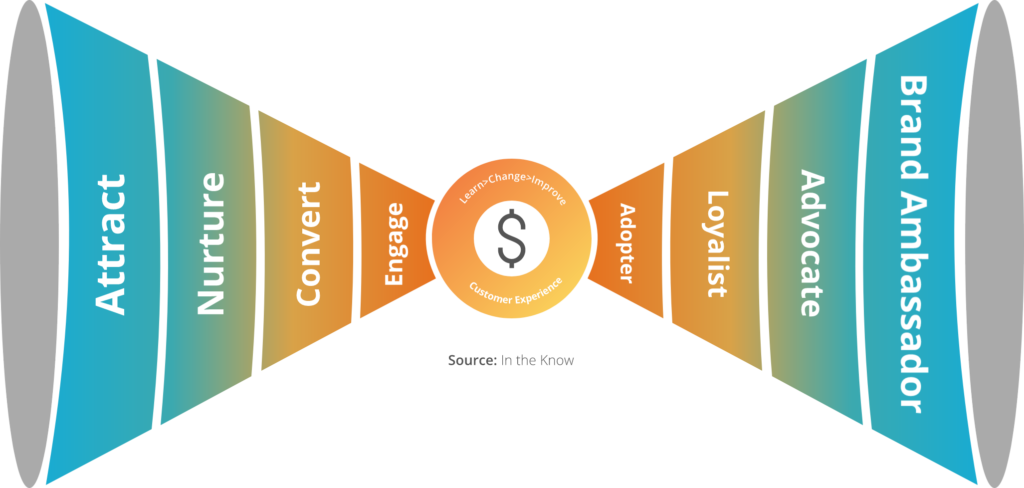
More on Customer Experience
What is Customer Relationship Management (CRM) and how does it support marketing?
-
Team Eela
Customer Relationship – Building a relationship between the customer and the brand begins with an introduction, the awareness phase. It sets the foundation to a long-lasting relationship, and in a way could be likened to first impressions. Today, modern businesses rely on customer experience to stand apart from competitors; in such a situation, first impressions certainly matter.
Just as is the case with human interactions, a relationship between the brand and the customer is also continuous, or rather circular – as described in the third chapter of this series. But to understand the process and customer experience journey entirely, it’s best broken down into the segments that follow.
Ongoing Exposure Phase: Learning About the Brand
Accumulated impressions are a dormant part of the consumer consciousness, until activated. The activation occurs through a trigger, the impulse to research and buy. Impressions from conversations, both offline and online, social media, peer reviews, and more, impact the initial range of options a consumer considers when preparing for a purchase. Simply put, an initial consideration set.
A brand’s inclusion in or exclusion from that set usually determines the potency of a company’s marketing efforts.
Customer Journey: An Interconnected Feedback Loop
Expectations form through the first purchase, and these expectations play an important role as the consumer enters the journey loop once more. Even without actively looking to make a purchase, a consumer is constantly exposed to different brands in subtle formats. It’s why the process likens to a loop. Consumers often circle back after a purchase, returning to the loop until another buying trigger occurs.
It’s not something buyers are even aware of, a cycle of constantly absorbing marketing messages as they handle their day-to-days. In a way, the post-purchase buying experience weighs on all future purchases, making it just as important as any other part of the how customer experience chronicles loops the customer journey.
At the same time, it’s important to remember that a loop doesn’t necessarily have to include your brand. As a business, you’re required to understand that a customer isn’t “yours” on the account of a purchase; they are still susceptible to impressions from other brands. You simply must earn their loyalty.
Capturing Loyalty: The Post-Purchase Phase
By now, you realize that customers are susceptible to being swayed, and that sales and marketing depend on it. Yes, you need to convince a buyer into making a purchase, but they are still open to considering different brands for future purchases. This is called passive loyalty.
After a purchase, your brand is perhaps now part of your customer’s consideration pool, but is he or she a brand ambassador yet? At the same time, it’s also possible to have not been included as a part of the consideration pool – even with a purchase from the past. It’s simple reality, and if you miss the boat on post-purchasing touchpoints, you might as well have departed from the pool. The point is to not rely on passive loyalty and inspire instead towards active loyalty.

Active loyalty is when a buyer shares, promotes, and writes positive reviews – of a product, service, or brand – across various channels in consumer use. With these types of customers, the consideration pool may merely include your brand or a short list of brands, including yours.
Active Evaluation Phase: The Highly Engaged Consumer
When a purchase desire triggers, granted the existence of a consideration pool, a buyer begins the evaluation of products or brands in said pool. This is known as the active evaluation phase. Through the research, it is also possible for the customer to increase his or her consideration pool. This further attests to the obliteration of the old sales funnel, indicating to a new buyer phenomenon. Read more to know how customer experience chronicles information drive buyer evolution.
With the purchase trigger activated, consumers notice marketing they had never previously noticed. They become engaged and aware of new brands, growing the consideration set as a consequence. Here, it’s important to remember that active evaluation depends largely on consumer-driven content. Most of the information covered by consumers during this stage includes:
It stands to reason that in a stage meant to narrow the consideration pool, buyers seek content that might help them make informed decisions. But let’s press pause here; it’s time to conclude and look forward to perhaps our final chapter in this series about customer experience. Stay tuned.

More on Customer Experience